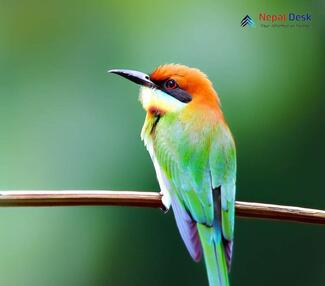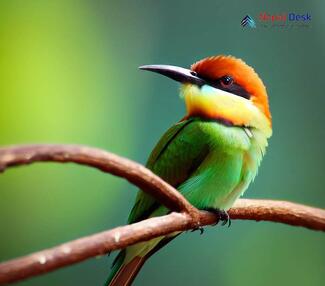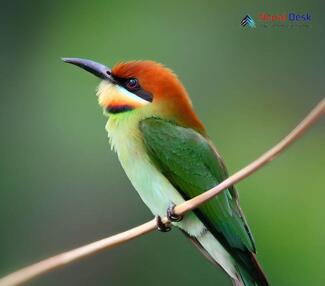The Chestnut-headed Bee-eater (Merops leschenaulti), also known as the Bay-headed Bee-eater, is a bird species that falls under the bee-eater family called Meropidae. Renowned for its lively aerial maneuvers and ability to catch insects, this stunning bird makes its home in the Nepal, India, and surrounding regions, covering areas up to Southeast Asia. Just like other bee-eaters, this species boasts vibrant colors and a slender body. Its distinctive call resembles that of the European bee-eater. The scientific name of this bird pays tribute to French botanist Jean Baptiste Leschenault de la Tour. Let us delve into the various aspects of this colourful bird:
Physical Characteristics and Habitat
The Chestnut-headed Bee-eater is a medium-sized bird with a slender body, an elongated tail, and a curved, sharp beak well-suited for catching insects in mid-air. As its name suggests, this bird boasts a striking chestnut-colored head that contrasts beautifully with its bright blue throat, green wings, and yellowish underparts.
Chestnut-headed Bee-eaters primarily inhabit open forests, woodlands, and riverine areas throughout much of South Asia, including Nepal. They are particularly drawn to regions where there is an ample supply of insects – their primary food sources – such as agricultural fields and even human settlements.
Diet and Feeding Habits
As their name implies, these birds have a penchant for bees but will also consume other flying insects such as wasps, butterflies, and dragonflies. They are masterful hunters that catch their prey on the wing by swiftly launching from perches or hovering before plucking the insect from mid-air. Once captured, they often return to their perch to beat the insect against a branch before swallowing it.
Breeding and Nesting Behavior
Chestnut-headed Bee-eaters are monogamous birds that form long-lasting pair bonds. Their breeding season typically occurs between March and June. During this time, male birds showcase their vibrant colors while performing acrobatic flights to impress potential mates.
After mating, both parents work together to dig tunnels into the soft soil of riverbanks or vertical cliffs. This is where they create a nesting chamber to lay their eggs. The mother will lay 4-8 eggs, and both parents take turns incubating the eggs for about 20 days. Once the chicks hatch, they remain inside the burrow for another 30 days before venturing out to explore their surroundings.
Conservation Status
Despite habitat loss due to deforestation and human encroachment, the Chestnut-headed Bee-eater is currently considered a species of "Least Concern" on the IUCN Red List. This is largely due to its extensive range across South Asia, from India and Nepal through Southeast Asia to Indonesia.
In conclusion, the Chestnut-headed Bee-eater is a remarkable bird that adds vibrant color and intrigue to Nepal's diverse avian life. Their aerial hunting skills, coupled with their captivating appearance, make them a must-see species for any birdwatcher or nature lover visiting Nepal or other parts of their native range. If you happen upon these fascinating birds in your travels, take a moment to appreciate their beauty, agility, and immense ecological value as part of our planet's incredible biodiversity.




